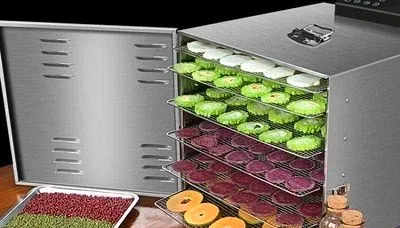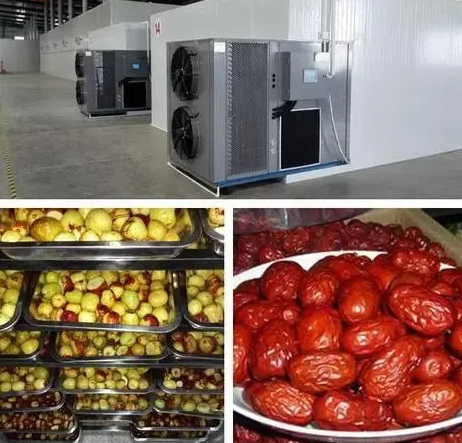
Content Menu
● Introduction
● What is an Industrial Heat Pump Dryer?
>> How Does It Work?
>> Key Components of a Heat Pump Dryer
● Benefits of Using Industrial Heat Pump Dryers
>> 1. Energy Efficiency
>> 2. Quality Preservation
>> 3. Versatility
>> 4. Environmental Benefits
>> 5. Consistent Drying Results
● Applications of Food Dryers
>> Case Studies in Food Drying
● Key Considerations When Choosing a Heat Pump Dryer
>> Maintenance Tips for Heat Pump Dryers
● Market Trends in Industrial Heat Pump Dryers
● Conclusion
● Frequently Asked Questions
>> 1. What types of foods can be dried using industrial heat pump dryers?
>> 2. How much energy does a heat pump dryer use compared to traditional dryers?
>> 3. What are the main advantages of using industrial heat pump dryers?
>> 4. Are there any specific maintenance requirements for heat pump dryers?
>> 5. Can small businesses afford industrial heat pump dryers?
Introduction
In the world of food processing, maintaining quality while ensuring efficiency is paramount. One of the most effective methods for preserving food is through drying, and industrial heat pump dryers have become a game-changer in this field. This article delves into the workings, benefits, and applications of food dryers, particularly focusing on how much energy does a heat pump dryer use.

What is an Industrial Heat Pump Dryer?
An industrial heat pump dryer is a sophisticated machine designed to remove moisture from food products while preserving their quality. Unlike traditional drying methods that rely on high temperatures, heat pump dryers utilize a closed-loop system that recycles energy, making them more efficient and environmentally friendly.
How Does It Work?
The process begins with air being drawn into the dryer. The heat pump then extracts moisture from the air and transfers it to a refrigerant. This refrigerant is compressed, raising its temperature before being circulated back into the drying chamber. The warm air then evaporates moisture from the food, which is subsequently removed from the system.
Key Components of a Heat Pump Dryer
- Evaporator: Absorbs heat from the air and evaporates refrigerant.
- Compressor: Increases the pressure and temperature of the refrigerant.
- Condenser: Releases heat back into the drying chamber while condensing the refrigerant.
- Expansion Valve: Reduces the pressure of the refrigerant before it re-enters the evaporator.
Benefits of Using Industrial Heat Pump Dryers
1. Energy Efficiency
One of the most significant advantages of heat pump dryers is their energy efficiency. So, how much energy does a heat pump dryer use? Typically, they consume less energy compared to conventional dryers due to their ability to recycle heat within the system. This can lead to substantial savings in operational costs for businesses.
2. Quality Preservation
Heat pump dryers operate at lower temperatures, which helps in preserving the nutritional value and flavor of the food. This is particularly important for products like fruits and vegetables, where high temperatures can degrade quality.
3. Versatility
These dryers can be used for a wide variety of food products, including fruits, vegetables, herbs, and even meats. Their adjustable settings allow for tailored drying processes that suit different types of foods.
4. Environmental Benefits
By using less energy and producing less waste heat compared to traditional methods, industrial heat pump dryers contribute positively to reducing carbon footprints in food processing facilities.
5. Consistent Drying Results
Heat pump dryers provide uniform drying conditions, ensuring that all parts of the product are dried evenly. This consistency is crucial for maintaining product quality and shelf life.
Applications of Food Dryers
Industrial heat pump dryers are utilized across various sectors in the food industry:
- Fruit and Vegetable Processing: Ensuring that dried products maintain their color and nutrients.
- Herb Drying: Preserving essential oils and flavors.
- Meat Drying: Creating jerky or other dried meat products without compromising safety or quality.
- Snack Production: Making healthy snacks from fruits and vegetables.

Case Studies in Food Drying
1. Fruit Processing Plants: Many fruit processing facilities have adopted heat pump dryers to enhance their production lines. For example, a company specializing in dried apples reported a 30% reduction in energy costs after switching to a heat pump dryer.
2. Vegetable Dehydration: A vegetable processing plant utilized heat pump technology to dry carrots efficiently while retaining their vibrant color and nutrients, resulting in higher customer satisfaction.
3. Herb Drying Operations: An herb farm found that using a heat pump dryer improved their drying process by allowing them to maintain essential oils in basil and oregano, leading to better flavor profiles in their final products.
Key Considerations When Choosing a Heat Pump Dryer
When selecting an industrial heat pump dryer for your business, consider the following factors:
- Capacity: Ensure that the dryer can handle your production volume.
- Energy Consumption: Look for models with low energy usage to maximize savings.
- Temperature Control: Adjustable settings are crucial for different food types.
- Maintenance Requirements: Choose a model that is easy to maintain to minimize downtime.
Maintenance Tips for Heat Pump Dryers
Regular maintenance is essential for ensuring optimal performance:
- Clean Filters Regularly: Clogged filters can reduce efficiency.
- Inspect Seals and Insulation: Ensure there are no leaks that could waste energy.
- Schedule Professional Servicing: Regular check-ups by professionals can prevent major issues down the line.
Market Trends in Industrial Heat Pump Dryers
As industries continue to focus on sustainability and efficiency, several trends are emerging:
- Increased Adoption of Energy-Efficient Technologies: More companies are recognizing the long-term savings associated with energy-efficient equipment like heat pump dryers.
- Integration with IoT Technologies: Smart technologies are being integrated into drying systems for better monitoring and control over processes.
- Focus on Sustainable Practices: Businesses are increasingly looking at ways to reduce their environmental impact through sustainable practices in food processing.
Conclusion
Industrial heat pump dryers represent a significant advancement in food preservation technology. Their energy efficiency, ability to maintain product quality, versatility, and environmental benefits make them an ideal choice for businesses looking to improve their drying processes. Understanding how much energy does a heat pump dryer use can also help businesses make informed decisions about their operational costs and environmental impact.
As we move towards more sustainable practices in food processing, investing in technologies like heat pump dryers will be crucial for companies aiming to stay competitive while also being environmentally responsible.

Frequently Asked Questions
1. What types of foods can be dried using industrial heat pump dryers?
Industrial heat pump dryers can be used for a wide range of foods including fruits, vegetables, herbs, meats, and even snacks.
2. How much energy does a heat pump dryer use compared to traditional dryers?
Heat pump dryers typically use significantly less energy than traditional dryers due to their efficient recycling of heat within the system.
3. What are the main advantages of using industrial heat pump dryers?
The main advantages include energy efficiency, preservation of food quality, versatility in applications, reduced environmental impact, and consistent drying results.
4. Are there any specific maintenance requirements for heat pump dryers?
Yes, regular cleaning and servicing are required to ensure optimal performance and longevity of the equipment.
5. Can small businesses afford industrial heat pump dryers?
While initial investment may be higher than traditional dryers, the long-term savings on energy costs often make them more economical for small businesses over time.












